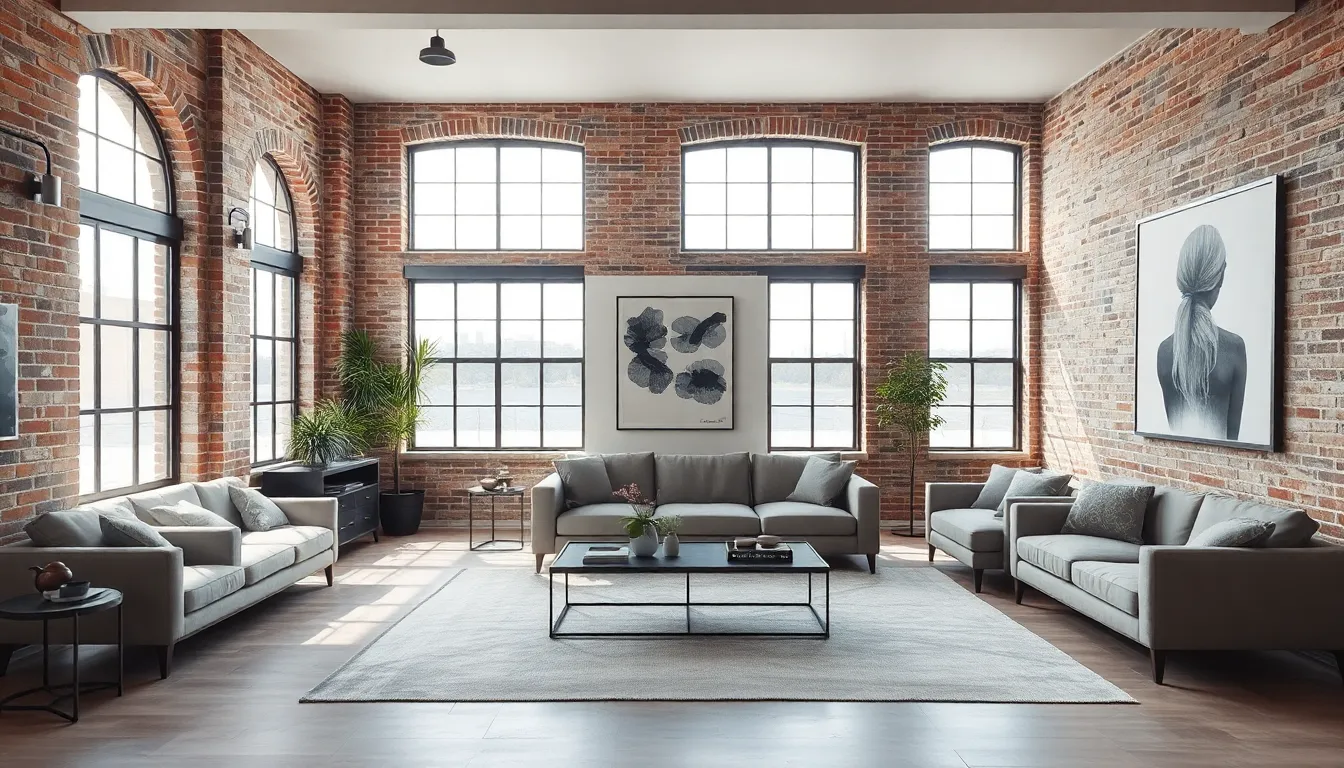Transforming a house into a home doesn’t have to involve a magic wand or a hefty budget. With a sprinkle of creativity and a dash of inspiration, anyone can elevate their living space from drab to fab. Home decor design ideas are the secret sauce that can turn bland walls into vibrant canvases and uninspired corners into cozy nooks.
Table of Contents
TogglePopular Home Decor Design Ideas
Transforming spaces can be as easy as incorporating popular home decor ideas. Using neutral color palettes creates a calming atmosphere. Layering textures adds depth and interest, enhancing a room’s overall aesthetic.
Incorporating plants introduces a lively element, improving air quality and adding a touch of nature. Using wall art, such as framed prints or canvases, personalizes spaces effectively. Utilizing statement furniture pieces, like a bold coffee table or unique chair, can serve as conversation starters.
Incorporating mirrors reflects light and makes rooms appear larger. Layering rugs creates cozy zones and defines different spaces within a room. Adding soft lighting options, like pendant lights or candles, fosters a warm environment.
Implementing open shelving displays decorative items while keeping everything organized. Experimenting with accent walls through paint or wallpaper serves as a dramatic focal point. Combining vintage finds with modern elements creates eclectic and unique decor.
Employing multifunctional furniture maximizes space utilization, especially in smaller areas. Choosing textiles, like cushions and throws, introduces color and comfort. Arranging furniture to facilitate conversation enhances social interaction in living spaces.
Opting for minimalist decor promotes simplicity and clarity, reducing visual clutter. Each idea serves to inspire creativity in home design, allowing for personalized, inviting spaces that resonate with individual tastes and lifestyles.
Modern Home Decor Styles

Modern home decor embraces simplicity and functionality, often integrating clean lines and muted tones.
Minimalist Design
Minimalist design maintains a focus on simplicity and organization. Elements are functional, featuring uncluttered spaces that promote serenity. Neutral colors dominate walls, furniture, and accessories, creating a cohesive look. Furnishings often have understated designs, allowing for easy adaptability in various spaces. Natural light plays a crucial role, enhancing ambiance while reducing reliance on artificial lighting. Choosing multifunctional furniture maximizes utility, particularly in smaller areas. Artwork remains sparse yet impactful, with select pieces guiding the viewer’s attention. Decluttering contributes to the overall tranquility of the environment, making minimalist decor an attractive choice for many.
Industrial Aesthetics
Industrial aesthetics reflect the raw and unfinished characteristics of urban environments. Exposed brick walls and concrete floors serve as fundamental elements, providing a bold backdrop. Metal fixtures and furniture add an edgy touch, often featuring reclaimed materials for an eco-friendly appeal. Combining vintage elements with modern accents creates intriguing contrasts, maintaining visual interest. Large windows enable natural light to fill spaces, highlighting the industrial theme. Open layouts encourage fluid movement, enhancing social interaction. Accessories, like pendant lights and pipe shelving, further emphasize the aesthetic while offering practicality. This style suits those who appreciate a blend of rustic charm and contemporary flair.
Tips for Choosing the Right Color Palette
Selecting a suitable color palette significantly influences the ambiance of home spaces. Consider how colors evoke emotions and shape perceptions.
Understanding Color Psychology
Color psychology plays a crucial role in home decor design decisions. Different hues can elicit specific feelings. For instance, blues often create a serene environment ideal for relaxation, while yellows can uplift one’s mood and energize a space. Reds may incite passion or warmth, making them suitable for dining areas. Neutral shades, such as grays and beiges, provide a versatile background that complements other design elements. Assessing personal preferences alongside these psychological effects leads to a balanced and harmonious atmosphere.
Complementary Colors
Complementary colors enhance visual appeal by creating contrast and balance. Pairing colors directly opposite each other on the color wheel can bring life to any room. For example, a vibrant teal works well with warm coral tones, creating an energetic vibe. Similarly, deep purple can be beautifully offset by a bright yellow, adding a touch of drama and excitement. Using complementary colors across different elements, such as furniture, artwork, and textiles, fosters a dynamic decor scheme. Ensuring these combinations align with personal style preferences results in a cohesive and inviting living space.
Incorporating Nature in Home Decor
Incorporating nature into home decor enhances spaces with warmth and tranquility. A few simple design elements can invite the beauty of the outdoors inside.
Indoor Plants
Indoor plants transform any space into a vibrant retreat. Popular options like snake plants or pothos improve air quality while adding a pop of green. They require minimal care, making them perfect for busy lifestyles. Grouping plants in varying heights creates visual interest and dimension. Placing larger plants in corners draws attention and fills empty spots. For smaller areas, hanging plants or wall-mounted planters maximize space and bring life to walls. Fresh herbs in the kitchen not only look appealing but serve a functional purpose too. Ultimately, incorporating indoor plants brings a refreshing, lively atmosphere indoors.
Natural Materials
Natural materials foster a connection with the environment. Wood furnishings introduce warmth and texture, offering both beauty and durability. Stone elements, like countertops or decorative accents, lend an organic feel. Linen and cotton textiles add softness while emphasizing sustainability. Choosing a mix of these materials creates depth and harmony in the decor. Furniture pieces made from reclaimed wood embody eco-friendliness and unique character. Bamboo decor options can enhance a sense of calm and tranquility. By using natural materials, individuals create inviting, grounded spaces that resonate with comfort and style.
Budget-Friendly Home Decor Ideas
Transforming spaces on a budget is entirely achievable with creative strategies. Thrift stores offer a treasure trove of unique items that can elevate a home. Painting old furniture can breathe new life into worn pieces while customizing their appearance.
Using removable wallpaper is another excellent option, providing a fresh look for walls without a long-term commitment. Swap out hardware on cabinets and drawers—modern knobs or handles can significantly update the overall aesthetic. Incorporate DIY projects; simple crafts not only save money but allow for personal expressions.
Consider repurposing everyday items. An old ladder works well as a bookshelf or display for plants. Turn wine crates into charming shelving units, adding character to any room.
Textiles play a crucial role in budget decor. Layering blankets and cushions introduces color and texture at minimal cost. Buy fabric remnants to create custom pillow covers or table runners.
Hanging art doesn’t have to be expensive. Create a gallery wall with framed photos, postcards, or even fabric swatches. This approach adds personality and warmth to living spaces.
Lastly, don’t underestimate the power of lighting. Swap out standard bulbs for warmer options, enhancing ambiance in rooms. Use string lights for a playful touch in spaces like bedrooms or outdoor patios.
Adopting these budget-friendly ideas allows for creating inviting environments without overspending. Each suggestion fosters a personal touch while keeping expenses in check.
Embracing creativity in home decor can transform any space into a personal sanctuary. By exploring various styles and incorporating elements like plants textures and colors individuals can create inviting environments that reflect their unique tastes. Whether opting for budget-friendly solutions or investing in statement pieces the key lies in balancing functionality with aesthetic appeal.
The journey of home decor is not just about beautifying spaces but also about fostering comfort and connection. With these design ideas anyone can elevate their living areas into vibrant havens that inspire and rejuvenate. It’s time to unleash creativity and make every corner of the home a true reflection of oneself.




